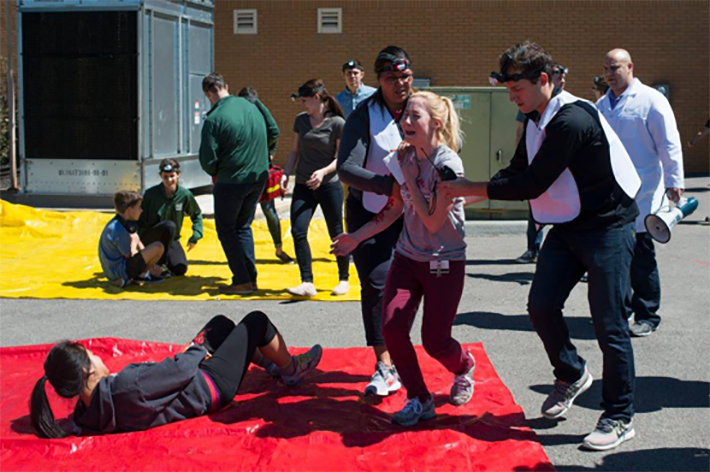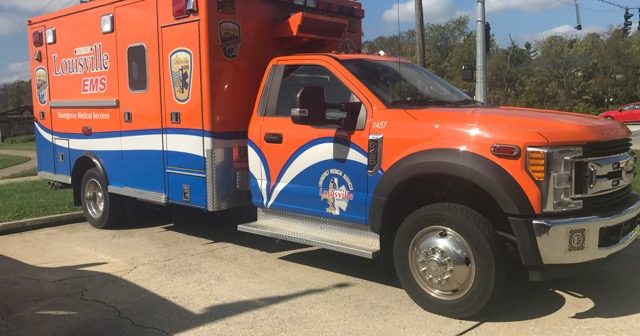National Two-Step CPR: Leading the Way in EM Philanthropy
Kevin Bennett, MS III - Florida International University Herbert Wertheim College of Medicine
EMRA MSC Southeast 2 Regional Representative, 2021-2022
Bhakti Sanghani OMS4, Philadelphia College of Osteopathic Medicine Georgia
Chest Compression-only CPR (CC-CPR) is a concept that has been studied, practiced, and recommended as an intervention for lay-person response to out-of-hospital cardiac arrest (OHCA) for years; however, it was not until the past decade that organizations emerged with the sole purpose of mass CC-CPR education. One such organization is National Two-Step CPR, which was originally founded by a group of medical students desiring a formal way to improve their community’s response to OHCA. This humble idea snowballed into a nationwide philanthropic initiative with events hosted by medical schools across the country, local and national media coverage, and a growing sense of opportunity for medical students wanting to make a difference in their community. Today, National Two-Step CPR remains a prominent annual volunteer event for many medical schools, and over 25,000 individuals across the country have been educated in CC-CPR to date. The creativity of the post-COVID world has given birth to new opportunities that aim to put medical students at the forefront of research, teaching, and promotion of public CC-CPR knowledge.
While ample formal research has been performed on the benefits and shortcomings of CC-CPR, one Cochrane systematic review from 2017 stands out as a shining endorsement of its efficacy. Four randomized-controlled trials (RCTs) comparing CC-CPR to traditional CPR, totaling 26,742 participants, were analyzed [1]. The main results show that untrained bystander CC-CPR with telephone instruction increases survival to hospital discharge vs traditional CPR with rescue breaths. These results are particularly exciting when you consider the monetary and time cost associated with traditional CPR training, the deterioration of skills without frequent practice or re-training [2, 3], and the proven efficacy of brief interventions similar to the National Two-Step CPR education model [4]. The explosion of research has also made its way into the 2020 American Heart Association Guidelines for CPR and ECC where CC-CPR is recommended as an effective intervention for lay-person rescuers present during a witnessed OHCA. The point to be made here is that we have a proven effective technique to intervene during OHCA that is easy to learn, easy to teach, and bursting with opportunities for medical students to lead; this is where National Two-Step CPR comes in.
Previously, National Two-Step CPR provided an example and a banner for medical students to unite behind during a yearly push to train as many people as possible the two simple steps of 1) Call 9-1-1 and 2) begin CC-CPR. Today, the mission of Two-Step has grown to position MEDICAL STUDENTS - not just some organization - as the leaders in their community and in the national discussion on CC-CPR. In addition to national and local leadership opportunities, fundraising and logistics support, and a trusted brand that is growing in participation every year, Two-Step is making new strides to become a public voice in CPR research distribution and contribution through a new medical student journal club as well as a yearly publication of the National Two-Step CPR event data. Two-Step is also committed to drastically expanding the number of participating schools by working one-on-one with local chapter leaders, as well as continuing to grow the national media recognition of medical students leading the charge in all areas of CC-CPR. At every step along the way, Two-Step will call for students to act as ambassadors of the organization by writing RCT reviews for the journal club, recording short videos to be highlighted on our social media, and, of course, by continuing to put on as many Two-Step events as possible to best equip the public with this incredible life-saving knowledge. National Two-Step CPR is dedicated to your success as a student and future doctor, and we intend to see public CC-CPR education grow into a medical student-led effort that saves lives around the country.
References
- Zhan L, Yang LJ, Huang Y, He Q, Liu GJ. Continuous chest compression versus interrupted chest compression for cardiopulmonary resuscitation of non‐asphyxial out‐of‐hospital cardiac arrest. Cochrane Database of Systematic Reviews 2017, Issue 3. Art. No.: CD010134.
- Xu Y, Li J, Wu Y, Yue P, Wu F, Xu Y. An audio-visual review model enhanced one-year retention of cardiopulmonary resuscitation skills and knowledge: A randomized controlled trial. Int J Nurs Stud. 2020 Feb;102:103451.
- Anderson R, Sebaldt A, Lin Y, Cheng A. Optimal training frequency for acquisition and retention of high-quality CPR skills: A randomized trial. Resuscitation. 2019 Feb;135:153-161.
- Panchal AR, Meziab O, Stolz U, Anderson W, Bartlett M, Spaite DW, Bobrow BJ, Kern KB. The impact of ultra-brief chest compression-only CPR video training on responsiveness, compression rate, and hands-off time interval among bystanders in a shopping mall. Resuscitation. 2014 Sep;85(9):1287-90.
Related Content

Aug 17, 2022
National Two-Step CPR: Leading the Way in EM Philanthropy
Chest Compression-only CPR (CC-CPR) is a concept that has been studied, practiced, and recommended as an intervention for lay-person response to out-of-hospital cardiac arrest (OHCA) for years; however, it was not until the past decade that organizations emerged with the sole purpose of mass CC-CPR education. One such organization is National Two-Step CPR, which was originally founded by a group of medical students desiring a formal way to improve their community’s response to OHCA. This humble idea snowballed into a nation-wide philanthropic initiative with events hosted by medical schools across the country, local and national media coverage, and a growing sense of opportunity for medical students wanting to make a difference in their community.






